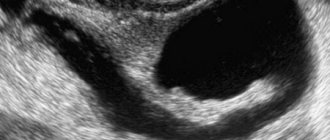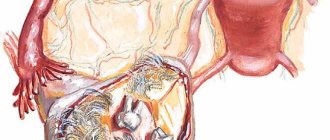Bleeding from the uterus is a serious symptom that can indicate many disorders in a woman’s body. Failure to provide emergency assistance in a timely manner can lead to complications. There are various causes of bleeding in women, so it is difficult to stop the symptom. In most cases, the secretion appears due to disturbances in the functioning of sex hormones. The main thing in treatment is timely diagnosis.
The occurrence of uterine bleeding cannot be ignored
Severity of blood loss
If we consider this issue globally, we can say that internal bleeding is one in which the spilled blood does not have direct contact with the external environment.
Therefore, many do not classify bleeding from the stomach and intestines as internal. But, if we take into account that they may not cause specific symptoms for a long time, then it is advisable to consider them in the context of internal ones. All types of internal bleeding and their corresponding specific symptoms are shown in a visual table.
| Type of bleeding | How to spot internal bleeding |
| Bleeding into the free abdominal cavity (ruptures of internal organs: liver, spleen) |
|
| Bleeding from the pelvic organs (ruptures of the ovaries, uterus and fallopian tubes) |
|
| Bleeding into the retroperitoneal space (ruptures of the abdominal aorta, kidneys and adrenal glands) |
|
| Gastrointestinal bleeding (diseases of the stomach, small and large intestines, leading to exposure of blood vessels) |
|
Laparoscopy is the most modern method for diagnosing and treating internal bleeding
When diagnosing internal bleeding in the abdominal cavity, the severity level must be indicated. She may be:
- mild – loss of up to 15% of the total volume of blood circulating in the vascular bed;
- moderate severity – loss from 15 to 20%;
- severe – reduction in blood volume by 30%;
- extremely severe or terminal - loss of more than 30% of the total blood volume.
Hemorrhage of more than 60% is considered fatal.
Symptoms of blood loss develop gradually and become more severe as the condition worsens.
Mild blood loss is usually asymptomatic. The patient's condition is satisfactory.
Moderate bleeding is manifested by a decrease in systolic pressure to 80 mmHg. Art., an increase in heart rate to 100-110 beats per minute, a change in the color of the skin (pallor), coldness of the extremities.
Severe blood loss is characterized by an even greater decrease in blood pressure and a slower heartbeat. The patient's skin acquires a bluish tint, the cyanosis of the nasolabial triangle is especially visible. Due to the loss of a large amount of blood, a decrease in diuresis (oliguria) is observed. The patient is lethargic and drowsy.
With terminal blood loss, the pressure drops below 50 mm Hg. Art., the pulse is practically not palpable. The patient's consciousness is impaired to the point of coma. There are signs of loss of a large amount of fluid: sunken eyeballs, a large number of skin folds, sagging skin, dry mucous membranes.
In the final stages, the patient's condition is extremely serious. Diuresis is completely absent, pressure drops to zero. Stopping bleeding and clinical death are possible. In such cases, immediate cardiopulmonary resuscitation is necessary.
DETAILS: Miliaria in adults photo symptoms and treatment
Etiology
Since a wide range of predisposing factors can cause the appearance of such a sign, they are usually divided into several large groups. The first of them identifies extragenital sources, i.e. those that have nothing to do with disruption of the functioning of the organs of the reproductive system:
- the course of infectious processes;
- diseases of the hematopoietic system;
- liver damage by cirrhosis;
- diseases of the cardiovascular system - this includes atherosclerosis and arterial hypertension;
- disruption of the functionality of the endocrine system.
Dysfunctional uterine bleeding (DUB) is those hemorrhages that occur for any reason related to the female reproductive system. Among these predisposing factors are:
- malignant or benign neoplasms in the ovaries or uterus;
- spontaneous rupture of a cyst or ovary;
- a wide range of uterine injuries;
- cervical diseases;
- damage to the external female genitalia;
- long-term use of contraceptives;
- sexual violence.
Fibroids in the uterus can cause uterine bleeding
Since dysfunctional uterine bleeding has no age restrictions, it often occurs in females during pregnancy. During this period of life, the source of such a sign can be:
- pregnancy outside the uterus;
- any pathologies of the ovum;
- presence of scars on the uterus;
- early placental abruption, its abnormal location or presentation;
- uterine rupture immediately during the birth of the baby;
- injury to the birth canal;
- the occurrence of various processes that can lead to the destruction of uterine tissue;
- infringement or delay of the place that should go away after childbirth;
- labor performed by caesarean section;
- uterine fibroids or endometritis;
- chorionepithelioma or trophoblastic disease.
In addition, the causes of uterine bleeding can be considered:
- lack of vitamins in the body;
- prolonged exposure to stressful situations or nervous strain;
- climate change;
- physical fatigue;
- work that involves contact with toxins or heavy metals.
Causes of pathology formation
The most common causes of internal bleeding include the following:
- Varicose veins of the esophagus or stomach.
- Tumors that have begun to disintegrate in the organs of the gastrointestinal tract and retroperitoneal spaces.
- Internal or external injuries in the abdominal area with damage to organs.
- Rupture of the hand (ovarian or pelvic).
- Physical exercise. Active sports can provoke rupture of cysts of various origins.
- Injuries in the lumbar region.
- Aortic aneurysms.
- Ulcers.
- Rupture or damage to the mucous membrane of the esophagus and intestines.
Prerequisites for uterine bleeding
the development of adenomyosis leads to uterine bleeding
Experts define almost all pathological bloody discharge of unknown origin in women as dysfunctional uterine bleeding - the prerequisites for the disease are established. it's possible.
Breakthrough uterine bleeding causes hormonal disruptions. If the menstrual cycle is normal, then the hormones work like a clock. They provide the necessary balance between estrogen and progesterone, so menstruation is not heavy and always begins on time. Hormonal balance has a kind of influence on the monthly growth, as well as on the rejection of the inner lining of the uterus. If the hormonal balance is disturbed, then the endometrium grows greatly. Therefore, it is rejected in parts, which is why uterine bleeding occurs.
Hormonal disorders most often affect teenage girls and adult women during menopause. Experts explain this by the fact that in adolescents, the hormonal control system is just awakening during the first year and a half after the start of menstruation, and in women at the beginning of menopause she suspends her activities. Therefore, in both cases, the balance of hormones is disrupted.
Various disorders in the body can cause uterine bleeding - the causes of the disease lie in related problems.
The causes of uterine bleeding can also be:
hypothyroidism (hyperthyroidism), i.e. functional disorders of the thyroid gland (profuse uterine bleeding) - blood diseases (for example, if there is a decreased content of platelets in the blood, which They are blamed for blood clotting) - prolonged uterine bleeding also occurs due to a lack of iron in the body, i.e. for anemia. It is worth noting that uterine bleeding with clots affects the decrease in hemoglobin in the blood. In this case, the woman complains of fatigue or weakness, as well as frequent migraines. She has a pale complexion.
How to recognize uterine bleeding:
Uterine bleeding with fibroids can be profuse and lasts a very long time. If the fibroid is located inside the uterus, then the bleeding is very severe. This location of fibroids is called submucosal. With this type of fibroid, surgical intervention is always necessary, since drug therapy is pointless. There will be no effect of treatment - if the inner layer of the uterus is embedded in its muscle, then adenomyosis will form. With this disease, the area of menstruating tissue increases in size, but the uterus practically does not shrink.
Therefore, menstruation becomes abundant. They continue for a long time and gradually turn into uterine bleeding, which is accompanied by pain - benign growths - endometrial polyps - may appear in the inner layer of the uterus etria. They are also one of the circumstances of profuse uterine bleeding, which can be prolonged or acyclic.
Endometrial polyps can occur in women of different ages, but most often they appear during the reproductive period. They are usually removed during hysteroscopy and hysteroresectoscopy. There is no drug therapy for this disease; in case of miscarriage in early pregnancy and in case of ectopic pregnancy, profuse uterine bleeding occurs None of the diseases, such as cancer of the uterus or its cervix, as well as the ovaries, contribute to the occurrence of profuse uterine bleeding - uterine bleeding after childbirth can this will lead to anemia, and in the worst case – to death.
It should be noted that due to intrauterine contraceptives, such as the IUD, uterine bleeding may occur as a side effect. Also, uterine bleeding can appear as a complication when taking aspirin or anticoagulants, which are taken to prevent blood clots.
Main reasons
Signs of internal bleeding into the abdominal cavity develop in the following pathological conditions:
- Injuries of parenchymal internal organs: liver, spleen, ovaries in women.
- Bleeding from the wall of the stomach or intestines, which is caused by an ulcer or malignant tumor.
- Cirrhosis of the liver, which causes increased pressure in the venous vessels. Rupture of these vessels leads to severe bleeding from the esophagus and stomach.
- Dissection of the abdominal aorta due to thinning of its wall with the formation of an aneurysm (sac-like bulging).
- Rupture of the gastric mucosa (Mallory-Weiss syndrome).
- Ectopic pregnancy or apoplexy, that is, ovarian rupture in women.
- Rupture of the cystic cavity of the ovary due to increased physical activity.
- Postpartum hemorrhage or hemorrhage during childbirth. Although in most cases the blood leaks out, internal bleeding can sometimes occur. For example, detachment of the placenta in the center and the formation of a hematoma behind the placental tissue.
Some may argue that uterine bleeding is intra-abdominal, since the uterus is an organ of the pelvic cavity. But in pregnant women it reaches large sizes and goes far beyond its limits. Therefore, symptoms of internal bleeding into the abdominal cavity in women may occur during pregnancy.
Local signs arise due to the accumulation of blood in the abdominal cavity and irritation of the nerve endings of the peritoneum. Because of these local symptoms, intra-abdominal bleeding can easily be confused with peritonitis (inflammation of the peritoneum). The main signs of peritoneal irritation are presented below:
- Positive Shchetkin-Blumberg symptom. To induce it, the surgeon presses his fingers on the patient’s anterior abdominal wall. Then he suddenly lets go of his hand. The appearance of pain when releasing the hand indicates irritation of the peritoneum.
- Tension of the anterior abdominal wall, immobility when breathing. This is due to the fact that it is painful for the patient to contract the muscles.
- Diffuse soreness throughout the abdomen.
General signs of internal bleeding into the abdominal cavity are not strictly specific. They occur with any loss of blood. The most important such signs include:
- Pale skin.
- Fall in blood pressure.
- Cold sweat.
- Feeling dizzy.
- Fatigue and lethargy.
- Increased heart rate.
Causes of uterine bleeding
The likelihood of uterine bleeding depends on the age of the patient. In girls from 12 to 18 years old, copious discharge of blood from the vagina is a consequence of hormonal imbalance. And hormonal imbalances at a young age arise due to:
- physical injury or emotional distress;
- deterioration of the functioning of the endocrine glands;
- poor nutrition, deficiency of vitamins in the body;
- pregnancy with complications, difficult childbirth;
- genital tuberculosis;
- bleeding disorders;
- suffered severe infectious diseases.
In mature women, uterine bleeding is a rare occurrence, usually associated with impaired ovarian function. In this case, the provocateurs of the pathological condition are:
- stress, overwork, nervous tension, mental disorders;
- uterine fibroids;
- endometriosis;
- advanced endometritis;
- uterine polyps;
- oncology of the uterus or cervix;
- tumor formations in the ovaries;
- ectopic pregnancy, miscarriage, medical or instrumental abortion;
- infectious diseases of the reproductive organs;
- climate change, unfavorable environmental situation in the place of residence, harmful working conditions;
- taking medications that can disrupt the systemic functioning of the hypothalamus and pituitary gland.
Uterine bleeding is often observed in women during menopause. This is due to a decrease in the synthesis of gonadotropin by the pituitary gland.
As a result, the level of sex hormones in the female body begins to fluctuate, the menstrual cycle is disrupted, and the formation of follicles in the ovaries is disrupted. Frequent causes of bleeding from the uterus at the age of decline of reproductive function are:
- uterine fibroids;
- endometriosis;
- uterine polyposis;
- hormone-dependent ovarian tumors.
First aid
It is very important for everyone to know how to properly assist with bleeding in a woman or man. After all, you can save not only someone’s life, but also your own. What needs to be done first?
Algorithm of first aid actions for internal bleeding.
The tactics of providing emergency medical care are as follows:
- Try to place the victim in a horizontal position.
- Try to cool the area of bleeding (stomach, lower back, etc.)
- Call an ambulance or try to deliver the patient yourself to a medical facility located nearby. It is very important that the patient is in a lying position, otherwise the pathology may worsen even more, thereby putting the person’s life in danger.
DETAILS: Vertebro-basilar insufficiency: causes, symptoms and treatment of VBI
Vaginal blood but no period
A healthy woman has periods regularly and is not accompanied by discomfort or unpleasant symptoms. Irregular, heavy, spontaneous bleeding indicates developed dysfunction. For what reasons does it occur, and what symptoms can it be accompanied by?
Types of dysfunction
Sexual bleeding (uterine, vaginal) accompanies many gynecological disorders, pathology of pregnancy, labor, and the early postpartum period. In rare cases, blood loss from the genital tract is a consequence of injury or pathology in the hematopoietic system.
There are many reasons for this condition. They vary in intensity and can lead to different consequences.
Vaginal bleeding is directly related to infection or mechanical injury, and uterine bleeding is directly related to diseases, hormonal dysfunction, and ovulation.
Starting in adolescence with menstruation, regular loss of blood from the vagina begins to accompany every healthy woman, and this is the norm. On average, physiological blood loss ranges from 40 to 80 ml.
Abnormal conditions and reasons why there is bleeding from the vagina:
- Dysfunctional disorder is pathological bleeding due to hormonal disorders.
- An organic disorder is pathological bleeding that develops with pathology of the genital organs.
- An iatrogenic disorder in which bleeding is a consequence of taking contraceptives, antithrombic drugs, or installing an IUD.
- Uterine bleeding during gestation, labor, and the postpartum period.
- Juvenile bleeding.
- Dysfunction in postmenopause.
The nature of vaginal bleeding can be cyclical (menorrhagia) or acyclic (metrorrhagia).
Menorrhagia
Menorrhagia can be caused by endometritis, fibroids, or endometriosis. With the development of these pathologies, the uterine wall loses its normal contractility, and this intensifies and prolongs vaginal bleeding.
Endometritis
In the acute stage of infection, a woman develops a fever along with merorrhagia, and the lower third of the abdomen is painful. On examination, the body of the uterus is enlarged and painful. The disease in its chronic form passes without signs of fever, and no pronounced pain syndrome is observed. The development of endometritis is provoked by the post-abortion or postpartum period.
Myoma
With neoplasms, in addition to menorrhagic dysfunction, the woman is bothered by pain, discomfort of urination and defecation. During the examination, the doctor discovers an increase in the size of the uterus. The uterus has an uneven, bumpy surface, compacted, palpation does not cause pain. With pathology, alternation of menorrhagia with metrorrhagia is possible.
Endometriosis
With endometriosis, menorrhagia is accompanied by pain (algomenorrhea), which progresses over time. During the examination, the doctor notes an enlarged uterus. The smoothness of the surface is preserved in case of endometriosis.
Regardless of the pathology, menorrhagia is profuse bleeding with clots. The woman complains of weakness, a sharp deterioration in her general condition, dizziness, and fainting.
Metrorrhagia
If a woman does not have her period, but is bleeding, then this is metrorrhagia. This condition develops against the background of physical and psychological fatigue, work in hazardous work, inflammatory diseases, neoplasms and endocrine disorders.
Metrorrhagia occurs at any time, and if a woman bleeds spontaneously, “out of the blue,” the acute stage of the process is in progress. Chronic metrorrhagia is defined by prolonged intermenstrual bleeding with disrupted cyclicity.
Anovulatory metrorrhagia
Adolescent girls and menopausal women are susceptible to this type of dysfunction.
With anovulatory metrorrhagia, ovulation and formation of the corpus luteum do not occur, menstruation is delayed, and bleeding continues for more than 7 days.
Postmenopausal metrorrhagia
Dysfunction develops against the background of fading ovarian function. Menstruation is irregular at first, but eventually stops completely. With the onset of postmenopause, metrorrhagia is a symptom of the formation of benign and malignant tumors.
Surgical intervention
| Situation | Surgeons' actions |
| Minor internal hemorrhage with expected spontaneous arrest with minor blood loss (additional examinations revealed no severe injuries or accumulation of blood in the abdominal space that would threaten the patient’s life). | Observation of a patient in a hospital setting. Infusion treatment. Taking medications that can stop bleeding. |
| Severe form of hemorrhage (organs of the gastrointestinal tract, any type of formation and regardless of the cause of origin). | Immediate surgery. At the same time, infusion therapy is carried out. Inpatient treatment taking medications. |
Regardless of the severity and degree of internal bleeding of the body, it is necessary to seek medical help as quickly as possible, since in some cases it is necessary to immediately perform a surgical operation that can save a life. Ignoring certain symptoms can only aggravate the patient’s condition.
Symptoms
This pathology has several specific clinical manifestations, which can be divided into general and local.
Thus, common symptoms of uterine bleeding include:
- weakness and decreased performance;
- pale skin;
- fainting conditions;
- decrease in blood pressure levels.
Local signs of uterine bleeding:
- copious discharge of blood from the vagina;
- the appearance of multiple blood clots during menstruation, which require frequent replacement of hygiene products, approximately every two hours;
- the appearance of bloody discharge after sexual intercourse;
- mismatch of hemorrhages with the period of menstruation;
- the appearance of pain syndrome. However, it is worth considering that such a sign is not typical for dysfunctional uterine bleeding.
It is generally accepted that upon the onset of menopause, representatives of the fairer sex do not experience bleeding, but this is not at all true. During this period of life, women need to monitor their character and quantity. The following signs of uterine bleeding during menopause should cause alarm and prompt you to seek qualified help:
- excessive hemorrhages that hygiene products cannot cope with;
- the appearance of a large number of bloody clots;
- The duration of hemorrhages is more than three days.
Features of internal bleeding in women
Separately, it is worth paying attention to the outpouring of blood into the abdominal cavity in women. The most common causes are ectopic pregnancy, cyst rupture and ovarian apoplexy.
Symptoms of internal bleeding into the abdominal cavity during ectopic pregnancy are quite specific. When a pipe ruptures, sharp pain occurs in the lower abdomen, and the patient’s condition sharply worsens. Blood pressure and pulse drop, cold sweat appears throughout the body.
Symptoms of internal bleeding into the abdominal cavity from the ovary are similar to those of a ruptured tube. Data from gynecological and ultrasound examinations help distinguish these two conditions.
Classification
In addition, DMK is divided into several types:
- juvenile uterine bleeding - appears in girls from twelve to eighteen years of age;
- hemorrhages of the reproductive period - observed in females of childbearing age - from eighteen to forty-five years;
- premenopausal bleeding – occurs in females during menopause.
In addition, there are several types of dysfunctional uterine bleeding:
- Menorrhagia is excessive and prolonged menstruation that lasts more than seven days, during which time a woman loses more than 80 milliliters of blood. The interval between such hemorrhages ranges from three weeks to thirty-five days;
- metrorrhagia is irregular bleeding that occurs during the intermenstrual period and is not intense;
- menometrorrhagia - bleeding is characterized by its irregularity, but it is quite long-lasting;
- Polymenorrhea is frequent menstruation, the interval of which is less than twenty-one days.
All of the above forms can be combined into abnormal uterine bleeding. Normal menstruation in women should last no more than five days, with equal breaks, which should be twenty-eight days. In addition, they should not contain large or multiple blood clots.
Depending on the causes of uterine bleeding, this symptom is divided into:
- dysfunctional uterine bleeding – associated with disruption of the normal functioning of the ovaries and the release of sex hormones;
- organic bleeding associated with uterine pathologies;
- Iatrogenic hemorrhages - occur due to the adverse effects of medications, both hormonal and non-hormonal.
In relation to pregnancy, this disorder is divided into:
- uterine hemorrhages during pregnancy;
- postpartum hemorrhages, which are divided into early and late postpartum periods.
Diagnostics: first stage
If there are symptoms of internal bleeding into the abdominal cavity in a child or adult, diagnosis begins with a medical history. If the patient’s condition is satisfactory and he is able to contact the doctor, he will ask him in detail about his symptoms and complaints.
Already during a conversation with the patient, you can determine the probable cause of bleeding. For example, for symptoms of internal bleeding into the abdominal cavity due to glass, trauma, liver disease or gastrointestinal tract. The symptoms will not differ significantly from each other, but the patient may indicate the fact of swallowing glass or a blow to the stomach.
Next they move on to an objective examination. Examine the skin, determining its color and moisture content. Be sure to measure the patient's blood pressure and pulse, since from these data the approximate amount of blood loss can be determined.
The abdominal cavity is palpated and the Shchetkin-Blumberg symptom is checked.
Is prevention possible?
As a preventative measure, the following rules must be observed:
- eliminate the cause of the secretion;
- undergo regular examination by a gynecologist (at least once every six months);
- If any deviations from the norm occur, consult a doctor;
Be sure to visit a doctor, only he can prescribe the correct treatment
- take oral contraceptives only after being prescribed by a specialist;
- plan pregnancy;
- follow the rules of a healthy lifestyle;
- eliminate stressful situations.
Laboratory diagnostics
After a conversation with the patient and an objective examination, the doctor prescribes the necessary laboratory and instrumental tests.
The most commonly performed laboratory tests are:
- blood analysis;
- stool test for occult blood;
- examination of vomit.
A complete blood count is performed to determine the presence of anemia. With massive acute blood loss, posthemorrhagic anemia develops, and with chronic bleeding, iron deficiency anemia is possible.
Treatment of uterine bleeding
in case of illness, medications are prescribed to stop bleeding
Stopping uterine bleeding is extremely important. For dysfunctional uterine bleeding, modern effective drugs that stop bleeding are prescribed, as well as hormonal drugs that are used as an emergency , and for long-term treatment. Answering the question of how to stop uterine bleeding, doctors talk, first of all, about hormonal drugs. They help restore the balance of hormones. They can be used both for ovarian dysfunction and for uterine bleeding. It should be noted that improper use of hormones contributes to the occurrence of uterine bleeding. Therefore, it is important to follow the prescribed dosage when using hormones.
Patients often ask the question of how to stop uterine bleeding at home. You shouldn’t be so irresponsible about your health! Teenage girls and young women need to avoid uterine curettage, which is not only unnecessary for them, but also harmful. It is necessary to take into account possible future pregnancies. Women of adolescence should undergo hysteroscopy or uterine curettage procedures, because This will allow the doctor to understand the causes of bleeding, and will also provide a therapeutic effect. It is necessary to remember that at present gynecologists have effective means that can quickly stop uterine bleeding, and examination and identification of preferred The causes of bleeding do not take much time.
Instrumental diagnostics
Instrumental diagnostics allows you to find the source of bleeding. The most informative methods are:
- colonoscopy - endoscopic examination of the small intestine, which reveals inflammatory or cancerous changes in its mucous membrane;
- esophagogastroduodenoscopy - a study of the esophagus, stomach and duodenum, which finds changes in the mucosa of these parts;
- ultrasound examination - allows you to see damage to the structure of parenchymal organs, the presence of free fluid in the abdominal cavity;
- Computed tomography is the most informative study for visualizing the abdominal organs.
DETAILS: Intraocular pressure (IOP): norm, symptoms and treatment
If, after carrying out the above examinations, there are still uncertainties, the surgeon performs a diagnostic laparoscopy. A small hole is made in the abdominal wall and a camera is inserted. The doctor sees a detailed image of all organs on the screen and thus finds the source of bleeding.
Treatment
First of all, it is necessary to take into account that uterine bleeding can begin at any moment, which is why you need to know the rules of first aid, which consist of:
- taking a horizontal position, so that the legs are several degrees higher than the rest of the body;
- applying a cold compress or ice pack to the lower abdomen;
- ingesting large amounts of liquid;
- taking hemostatic drugs for uterine bleeding.
It is strictly forbidden to douche, take a hot bath, or apply heat to the stomach.
The choice of bleeding control technique is based on the general condition of the patient and the intensity of the main symptom.
Juvenile uterine bleeding is treated in the following way:
- the use of hemostatic drugs and substances to contract the uterus;
- prescribing progesterone – if non-hormonal therapy is ineffective;
- performing hysteroscopy with separate diagnostic curettage – used for heavy hemorrhage;
- carrying out treatment of anemia.
Specialized care: conservative treatment
The ambulance transports the patient to the surgical department. There he receives specialized care.
If the patient's condition is satisfactory, urgent surgical intervention is not required. The victim is hospitalized in a hospital for further observation.
Conservative treatment of blood loss consists of infusion therapy. In order to restore the volume of lost blood, the patient is given droppers with saline solutions (isotonic sodium chloride, “Disol”, “Trisol”). In case of massive bleeding, infusion of substances with a higher molecular weight than saline solutions is indicated. To do this, “Reopoliglucin”, blood plasma, is administered.
Hemostatic agents are also administered: “Etamsylate”, aminocaproic acid.
If the patient’s condition is serious or there is no effect from drug therapy, they proceed to surgical treatment. An emergency laparotomy is performed. The surgeon makes an incision in the middle of the anterior wall of the abdominal cavity. Next, he removes the blood and conducts an audit of all organs in order to find the source of blood loss.
Once the surgeon has found the injury, he stops the bleeding. This can be done by ligating the ruptured vessel, applying clips, removing the affected organ, or resection of the damaged section of the intestine.
If symptoms of internal bleeding into the abdominal cavity appear after surgery, an urgent repeat laparotomy is performed.
Diagnostics
A gynecologist knows what to do in case of uterine bleeding, as well as how to diagnose it. Establishing the correct diagnosis is often not difficult for an experienced clinician.
Diagnostic measures consist of several stages, the first of which includes:
- conducting a detailed survey of the patient regarding the regularity, abundance and pain of the menstrual cycle. In addition, the survey will help identify the presence and intensity of accompanying symptoms;
- familiarization of the doctor with the medical history and life history of the patient - to search for etiological factors;
- performing a gynecological examination.
Among laboratory tests, it is worth highlighting general analysis and blood biochemistry. This is necessary to establish hormone levels, determine tumor markers and study coagulation. A laboratory test of a smear taken from the cervix may also be required.
The basis of diagnosis is instrumental examinations, which include:
- Ultrasound of the pelvic organs;
- examination of the vaginal walls;
- diagnostic curettage;
- hysteroscopy – involves examining the uterus using a special device;
- biopsies;
- MRI and CT.
Transvaginal ultrasound of the pelvis
Forecast
In 85% of cases, medication stops bleeding within a period of 3 to 7 days; surgical methods allow this to be done almost instantly; after 2–3 days only residual effects (slight bleeding) remain.
15% of bleeding cannot be stopped and ends in death. This occurs due to a combination of numerous factors and causes of the symptom (long-term progressive underlying disease, concomitant pathologies, development of malignant complications, late presentation).
Bleeding is one of the most common gynecological pathologies (from 20%), menopausal women (15%) and juvenile girls (12–18 years old, 20%) suffer more often.
First aid
If uterine bleeding occurs, you should call an ambulance, since the woman’s condition quickly worsens with blood loss. Tactics in providing assistance affect the result. To avoid making the situation worse, the following actions should be avoided:
- Do not apply a warm heating pad;
- do vaginal douching;
- to take a bath;
- massage your stomach.
| What to do | Tactics | Benefit |
| Take a lying position | You need to lie down on the bed or floor. Keep your legs above head level with a bolster underneath them | Allows you to relax the muscles of the body. The flow of blood to the lower half of the body decreases. The risk of loss of consciousness is reduced |
| Apply a cold object to your stomach | An ice pack is used. It should be wrapped in cloth to prevent frostbite on the skin. You should keep the ice on your stomach for 10-15 minutes. Take a 5 minute break and continue. Do this procedure for an hour | Cold causes blood vessels to constrict. The amount of blood loss is reduced |
| Drink cold water | It is recommended to drink plenty of sweets during bleeding. | Allows you to replenish the lack of fluid in the body |
| Medicines | Inside, 0.25 g of Dicinone. Potassium gluconate – 3-4 times a day. Intravenous aminocaproic acid 30-50 ml. Tranexam – 2 ml 1-4 times a day. | Hemostatic drugs for uterine bleeding help stop blood loss |
| Hormonal | Monophasic combined oral contraceptives are used | This method is suitable for young girls who have not given birth. |
An ambulance hospitalizes a woman in a similar condition. At home, it is necessary to follow preventive measures to reduce the risk of bleeding:
- observe work and rest schedules;
- take anti-inflammatory drugs for the next 1-2 months;
- take vitamin C, D, B6 and B12;
- drink sedatives as needed;
- exercise with your doctor's permission.
When the pathological condition in question appears, the following activities are prohibited:
- Apply heat to your stomach.
- Take a warm shower, and even more so, a bath.
- Perform douching.
- Take any medications that cause uterine contractions without first consulting a doctor.
Before the ambulance arrives, you should adhere to the following recommendations:
- Adopting a horizontal position. It is advisable to place your feet on a hill. This will minimize serious consequences and help the patient remain conscious.
- Applying cold to the lower abdomen for 1-2 hours. Every 15 minutes it is necessary to take 5-minute breaks.
- Drink plenty of fluids. For these purposes, sweet tea or still water will do. You can also prepare a decoction of rose hips: the vitamin C it contains has a positive effect on strengthening the walls of blood vessels.
- Taking hemostatic drugs. Possible only after consultation with a doctor. Pregnant women should take them with extreme caution: such medications have certain side effects. This group of drugs includes Aminocaproic acid, Dicynone, tincture of water pepper, Vikasol.
Heavy menstruation
In every woman’s life, there comes a month in which menstrual bleeding is heavier and longer than usual. The reason for this may be stress, hypothermia, colds, taking certain medications, sudden changes in time zones and temperature zones.
In medicine, heavy menstruation is called menometrorrhagia - the most common type of uterine bleeding. This phenomenon is characterized by an increase in the duration of menstruation over 7 days and blood loss of more than 200 ml, however, the latter criterion is quite biased. More often, gynecologists use a more primitive criterion - the number of full pads per day. Five or more full pads used per day may indicate menometrorrhagia.
How to stop heavy menstruation?
Menometrorrhagia can be stopped at home, but such attempts without medical supervision are extremely undesirable and should not last more than 5 days. We list the main methods for stopping uterine bleeding at home:
- Complete refusal of sexual activity.
- Refrain from a warm bath and any warming procedures such as heating pads on the lower abdomen or lower back.
- The prone position may reduce bleeding slightly because the uterus contracts a little better in this position.
- A good choice for “home” stopping bleeding are the following medications: etamsylate or dicinone, water pepper extract, nettle and shepherd’s purse decoction. The duration of their use should not exceed 4–5 days. If it is clear that the flow of blood does not stop, you must immediately contact a gynecologist to adjust the treatment.
Bloody discharge in girls
Before the onset of puberty (9-12 years), there should be no vaginal discharge. During this period, eggs do not mature, menstrual function is not active, and the effect of female hormones on the child’s body is negligible. Therefore, bleeding at this age always indicates problems with the girl’s health. Most often this is due to pathologically premature puberty or infection of the genital tract.
There should be no bleeding during menopause. Their appearance indicates the development of a serious disease, including oncology. By seeking professional help from the specialists of the Diana Clinic, a woman can receive detailed advice from an experienced gynecologist, carry out the necessary diagnostics and the optimal treatment regimen for any gynecological pathology.
If you find an error, please select a piece of text and press Ctrl+Enter
Basic drugs
How to stop uterine bleeding? The drugs used for this purpose are hormonal drugs. They are considered the first line of drug therapy for patients with acute bleeding. Treatment options include combined oral contraceptives and oral progestins.
Antifibrinolytic drugs, such as tranexamic acid, are used to prevent fibrin degradation and are effective in treating patients with any form of bleeding. Tranexamic acid effectively reduces the rate of intraoperative blood loss and removes indications for blood transfusion in surgical patients.
Patients with bleeding disorders or those suspected of having excessive bleeding may develop unpredictable reactions to hormonal and non-hormonal treatments. For such patients, consultation with a hematologist is recommended, especially if the bleeding is quite difficult to control or the gynecologist cannot independently cope with this pathology. Desmopressin may help treat patients with von Willebrand disease if the woman is known to respond to the drug. It can be administered by intranasal inhalation, intravenously, or subcutaneously. This medication should be used with caution due to the risk of fluid retention and hyponatremia. It should not be given to patients with massive bleeding receiving intravenous resuscitation. Recombinant factor VIII and von Willebrand factor are also available and may be necessary to control major bleeding. Other deficiency factors may require factor-specific replacements.
Patients with bleeding disorders or platelet function disorders should avoid nonsteroidal anti-inflammatory drugs due to their effects on platelet aggregation and their interactions with substances that may affect liver function and the production of clotting factors.
Treatment methods
Bleeding can be stopped; this is vital, especially when the blood loss is acute and life-threatening; in 85% of cases this can be done (in 15% the pathology ends in death).
Treatment of any bleeding is carried out in a hospital setting; acute blood loss requires emergency first aid measures and calling an ambulance.
- Stop the bleeding.
- Replenish blood loss.
- Eliminate the cause of the symptom.
- Prevent recurrence of bleeding.
Drug therapy, infusion methods for restoring blood volumes and surgical methods are used, the latter are used if the bleeding is not stopped by medications.
How to give first aid
How to help before doctors arrive:
| Sharp weakness | |
| What not to do | What should be done |
| Stand, sit, lie on your side with your knees pulled up to your chin (in the “embryo” position) | Lay the patient flat on his back, without a pillow under his head. |
| Do warm baths and douches | Place a cushion under your feet, slightly lifting them (30–45 cm from the surface) |
| Apply a hot heating pad to your stomach | Place a plastic bottle, a heating pad with ice or ice water on the uterine area |
| Drink hot drinks | Provide plenty of cold drinks (still water, sweet tea, rose hip decoction) |
| Take medications without consulting a doctor |
Drug therapy
| Group of drugs | Name | What effect do they have? |
| Homeostatic agents (hemostatic agents) | Etamsylate, dicinone, aminocaproic acid, oxytocin, menadione | Increase blood clotting and the number of platelets, affect the tone of the uterine walls, cause its contraction, eliminate bleeding |
| Progesterone preparations | Norethisterone, levonorgestrel | Increase the amount of progesterone, stop bleeding when homeostatic drugs are ineffective |
| Oral contraceptives and gestagens | Dydrogesterone, janine, regulon | They contain combinations of estrogen and gestagens, stop bleeding more slowly than progesterone preparations, therefore they are more often used to prevent relapse (recurrence) |
| Vitamins | Rutin (P), ascorbic acid, folic acid (B9), other B vitamins (B6, B12) | Increase tone and strengthen blood vessels |
| Iron supplements | Maltofer, totema, tardiferon, | Restore hemoglobin levels |
The causes and treatment of uterine bleeding are directly dependent on each other: by identifying and treating the underlying disease, you can get rid of life-threatening consequences forever.
Infusion methods
Infusion methods (transfusion) are used to restore the volume of lost fluid, the number of red blood cells and platelets.
| Product name | What effect do they have? |
| Trisol, acesol, hemodez | Increase the volume of fluid in the body, restore the balance of electrolytes, prevent hypovolemic shock (from fluid loss) |
| Washed red blood cells and plasma from donor blood | Quickly restore the amount of red blood cells and fluid necessary for normal gas exchange and blood supply |
| Donor platelets | Help restore blood clotting factors |
Surgical methods of treatment
Used if it was not possible to stop uterine bleeding by other means (the patient’s condition worsens, hemoglobin drops below 70 G/l, blood volume rapidly decreases).
The procedures are performed on a gynecological chair; local or general anesthesia can be administered. Using gynecological instruments (dilators), access to the uterine cavity is opened; before the operation, the condition of the inner layer is determined using a hysteroscope (an optical device in a tube that is inserted into the uterine cavity).
| Method name | How are they performed? |
| Curettage of the uterine cavity | The endometrial layer in the uterine cavity is removed by scraping with a special device (curette) |
| Cryodestruction (destruction of tissue by cold exposure) | The endometrium is treated with liquid nitrogen using a special device - cryodestructor |
| Laser ablation (cauterization) | The endometrium is destroyed by introducing a device with a radiation source into the uterine cavity |
Internal bleeding and its types
Bleeding can develop as a result of injury or during exacerbation of chronic diseases.
Internal bleeding has several types, and the causes of its occurrence are taken into account:
Mechanical damage occurs to blood vessels due to trauma. Arrosive depends on how the vessel walls are damaged: with tumor and necrosis. Diapedetic hemorrhages occur in a condition of the vessels when their permeability is too great - this happens with sepsis and scurvy.
The types of bleeding are divided, taking into account the nature of the vessel that undergoes changes. This may be damage to an artery, vein or capillaries. It happens that the pathology affects one of the parenchymal organs, and such bleeding is called parenchymal.
Localization can be in the abdominal cavity, in the pleural and pericardial areas, inside the joint.
Common signs of bleeding
The main signs for all forms of bleeding that occur inside the body: weakness in the body, lethargy, blood pressure (BP) decreases significantly, the skin turns pale, and cold sweat appears.
Suspicion of such a condition should arise if there were provoking factors (impacts with blunt, piercing objects; injuries), diseases of the internal organs were diagnosed.
The patient may lose appetite, feel very thirsty, and even lose consciousness. How serious a person’s condition is can be recognized by certain signs.
If the bleeding is minor, then the pulse is intense - up to 80 beats per minute, and blood pressure decreases, other symptoms may be absent.
If the bleeding is moderate, the upper pressure drops to 90 mm. Hg Art. and below, the heart rate increases. In this case, the skin turns pale, hands and feet become cold, breathing quickens, nausea, weakness, dizziness appear, and all psychomotor reactions slow down.
In severe cases, the patient’s blood pressure drops significantly, the pulse is rapid, breathing is intermittent, cold sweat appears, drowsiness appears, trembling of the arms and legs, the eyes darken, vomiting begins, the skin turns pale, cyanosis develops, and the person’s condition is critical.
If the blood loss is massive, then the pressure drops sharply, the pulse is very fast - up to 160 beats per minute, the patient’s consciousness is confused, pale skin, delirium, cold sweat are observed, facial features become sharpened.
Fatal blood loss: slow pulse, low blood pressure, respiratory arrest, convulsions, dilated pupils, dry and pale skin, agony and death.
There are several types of bleeding: arterial, capillary, venous. The cause of arterial disease is damage to the artery by a sharp, cutting object, a gunshot wound; trauma resulting from blunt impact.
It is very difficult to stop bleeding on your own. Blood flows like a fountain inside and outside the organs; the victim can lose a critical volume of blood in a few minutes, which will lead to death.
Capillary – common. In this case, the surface of the internal organs may bleed, these include the liver, kidneys, and spleen.
Symptoms are mild at the very beginning, which complicates the diagnostic process. A stomach ulcer can cause it, and hemorrhage also occurs in the brain tissue. In this case, it is necessary to urgently provide assistance to the patient.
Venous is formed if the walls of the veins are damaged. The patient instantly develops symptoms of anemia, anemia, and a state of shock occurs. With venous bleeding, dangerous conditions can occur in which the escaping fluid accumulates in the pleural and retroperitoneal cavities.
Signs of uterine bleeding during the reproductive period
During the childbearing period, there are a lot of factors that can cause pathology.
This happens due to:
- Disturbances in the production of hormones after termination of pregnancy,
- When under stress,
- In the presence of infectious diseases,
- Intoxication,
- When taking medications.
During pregnancy, and especially in the early stages, the uterus may bleed due to miscarriage. In later stages, the uterus may bleed due to placenta previa. It is especially dangerous when it bleeds during and after childbirth, then the amount of blood loss can be very large.
The following diseases can also cause bleeding:
- Myoma,
- Endometriosis of the uterine body,
- Tumors in the cervix,
- Chronic inflammation of the cervix.
Special cases
There are cases when a woman herself does not understand why the described pathology suddenly manifests itself, or what factors are its predecessors. However, in some cases, it is the patient who knows the characteristics of her body who will help the doctor make a diagnosis. First aid for uterine bleeding will be provided correctly and in a timely manner, and subsequent treatment will be effective if you tell the specialist in detail about the existing symptoms.
Hemorrhages during pregnancy
The period of bearing a child is a crucial period in a woman’s life. Any disruptions in the functioning of the body should not be ignored. When there is a threat of miscarriage, blood is released from the reproductive organs. A reasonable question becomes, how to stop uterine bleeding in this case?
Self-administration of drugs is strictly prohibited; their prescription is carried out by a gynecologist after a thorough examination.
Breakthrough hemorrhages
This pathology often occurs as a result of long-term use of hormonal drugs and is accompanied by the release of large amounts of blood. In such a situation, uterine bleeding with clots is possible, how to stop it? The specialist will give an exact answer after examining the patient. The body may experience a malfunction due to the intake of hormones that increase the level of estrogen and provoke endometrial rejection. Triphasic contraceptives are usually prescribed; for elderly patients, progestins are prescribed.
Endometrial hyperplasia
How to stop uterine bleeding with endometrial hyperplasia? If hyperplasia is suspected, surgical intervention in the form of curettage of the uterine cavity, followed by treatment with hormonal agents, is indicated. If this pathology develops after curettage of the uterine cavity, progestins are prescribed, the administration of which can be intermittent or continuous, it all depends on the menstrual cycle. Bleeding with endometriosis is not uncommon.
Age adjustments
Hemorrhages often appear in women after 40 years of age during menopause. How to stop severe uterine bleeding in this case. Specialists prescribe drugs that stop bleeding, and surgical techniques are used. During menopause, significant changes occur in a woman’s body and the overall hormonal balance is disrupted. When the body “rebuilds” due to age-related characteristics, discharge from the uterus with clots appears. Every woman should be prepared for this and know the basic rules of first aid.
Myoma
Myoma is a benign formation of the uterine wall. The causes of hemorrhagic complications in this case:
- Intensive growth of the endometrium.
- Tumor enlargement.
- Decreased vascular elasticity
- Insufficient contraction of the uterus.
How to stop bleeding from fibroids. Most often, curettage of the uterine cavity is performed, during which the altered mucous layer is removed. A positive result, when it comes to small single nodes, is achieved with the parallel administration of hormonal drugs, the use of drugs that strengthen blood vessels and increase blood clotting. Bleeding with fibroids differs in intensity and frequency, which determines complex therapy.
It is not uncommon to experience bleeding when taking birth control pills.
At the beginning of their use, hormonal changes occur, and periodic rejection of endometrial tissue occurs in the form of small bloody lumps. These symptoms usually go away after 3-4 months of using contraceptives.
Description of the disease
Vaginal bleeding is the release of blood from the uterus. Most often it is a very serious symptom of pathologies in the female body. Any uterine discharge in the form of blood should be diagnosed in a timely manner, and the woman should receive medical care. Ignoring such symptoms leads to very dangerous consequences, and death is possible. It is important to know that normal vaginal bleeding includes only menstruation, the duration of which is five days, with stable breaks, the length of which is approximately twenty-eight days. Any other bleeding is considered a pathology and requires mandatory medical supervision. Now let's find out what are the reasons for this phenomenon.
Why is bleeding from the uterus dangerous?
If uterine hemorrhage does not end for a long time, then it is difficult to stop, which is why this pathology is very dangerous for women’s health and has the following consequences:
- Anemia may develop (if the volume of blood that comes out is more than 80 ml),
- Large blood loss due to hemorrhage, which is difficult to identify, most often requires surgical intervention,
- The danger of developing the underlying disease, which caused hemorrhage,
- Danger of hemorrhage in pregnant women or during the postpartum period
Causes of physiological bleeding
Physiological vaginal discharge mixed with blood that appears between two menstruation may be associated with the following reasons:
- Implantation bleeding – appears during conception and can continue until your period is missed. The bloody discharge is spotty and scanty, and in some cases may be accompanied by pain during sex.
- The first months of taking hormonal contraception - the first days of taking oral contraceptives may be accompanied by light, spotting discharge, which stops on its own after a few days.
- Skipping a birth control pill also causes a hormonal imbalance, which results in short-term bleeding.
- The intrauterine device is a contraceptive device that fits very tightly to the mucous membrane of the uterine cavity and irritates it, causing it to contract with redoubled force. It is this active work of the uterus that provokes bleeding.
- Aggressive sex - vaginal microtraumas that occur during aggressive sexual contact can also lead to bleeding, which does not pose a serious threat to a woman’s health.
Dark brown or reddish spotting may be observed for several days after your period stops. This manifestation is also considered normal and does not require the attention of a gynecologist.
Main symptoms of hemorrhage
- Menstruation lasts more than 8 days
- Lower abdominal pain,
- Menstrual blood loss is more than 120 ml,
- Weakness,
- Pale skin
- Dizziness,
- Fainting,
- Nausea, vomiting,
- Frequent pulse
- Low pressure,
- Anemia.
The main signs of vaginal blood loss:
- Dysfunctional hemorrhage is painless,
- After birth up to 2 months,
- Prolonged discharge after abortion,
- Blood loss while taking hormonal contraception,
- For polyps in the uterus,
- Fibroids inside the vagina,
- intrauterine pregnancy,
- Bloody discharge is associated with cancer.
Bleeding after childbirth
Bloody discharge (lochia) from the genital tract persists for several days (weeks) after childbirth. Over time, their intensity and color change, they become scanty and light, and then disappear altogether. Even in the maternity hospital, measures are taken for the young mother to prevent postpartum hemorrhage - the bladder is emptied using a catheter, ice is placed on the stomach, and oxytocin is administered intravenously. The drug is necessary for intense contraction of the walls of the uterus, which closes open blood vessels, preventing excessive blood loss.
To prevent postpartum hemorrhage, you must follow a few simple rules - empty your bladder in a timely manner, feed the baby on demand, lie on your stomach more often immediately after childbirth, and apply ice to your stomach.
Bloody postpartum discharge can persist for up to 6-8 weeks until the uterus is completely restored. For breastfeeding mothers, this process occurs faster. You should consult a doctor if the following signs appear:
- the discharge has an unpleasant odor;
- pus appears in the secretion;
- the volume of lochia has increased for no reason;
- Vaginal discharge acquires a cheesy consistency.
You need to monitor the nature of postpartum discharge and take timely measures to avoid serious health complications.
After an abortion, including a medical one, bleeding occurs for a week, sometimes for 10 days. After this period, they should stop completely.











